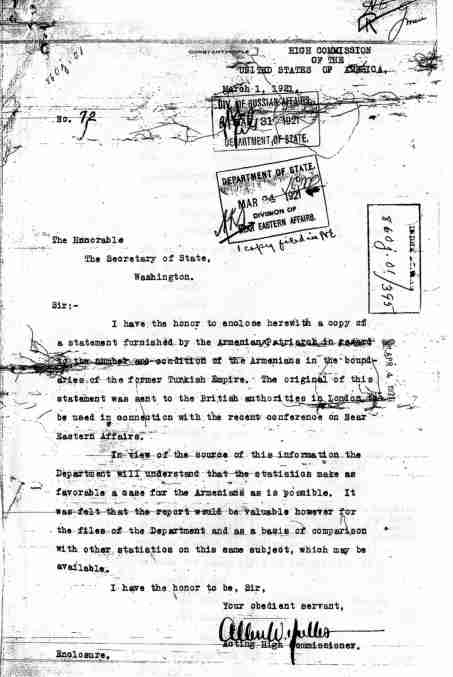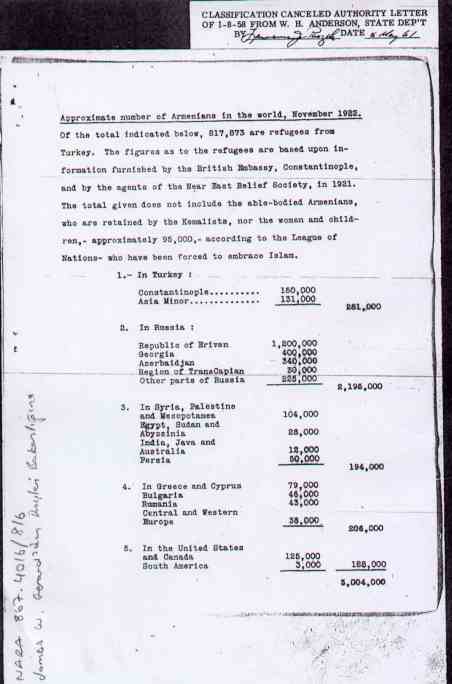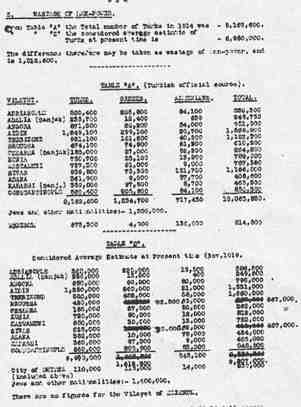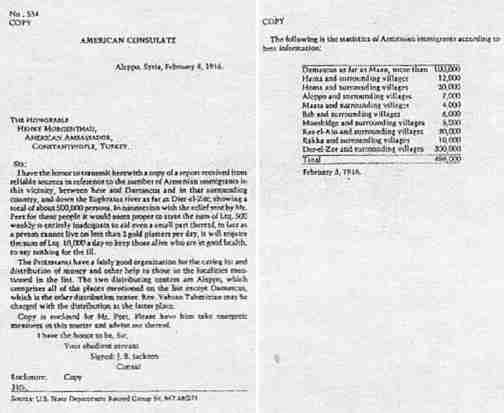|
|
TABLE OF CONTENTS:
1) 1921 Armenian
Table, from the Patriarch
2) Relevant references to above from "The
Armenian File"
3) World Armenian count, Nov. 1922
4) British population report, Nov. 1919
5) U.S. Consul Jackson on the number of the
"Deported"
|
|
|
| 644,900 Ottoman-Armenians in 1921 |
"In 1921, the Istanbul Patriarch, in a statistic he gave to
the British, showed the number of Armenians living within the Ottoman borders before the
Sevres Agreement as 625,000, including those who returned after they had emigrated."
The above is what Kamuran Gurun had written in "The Armenian File," and a
little more will be featured underneath the section below.
Gurun did not take into account the 20,000 "hidden" Armenians indicated at the
end of this report, bringing the total to 644,900.
A
copy of the original document may be seen here.
What is below is a transcription, but the information may not always be accurate.
The quality of the copy was not always clearly legible. The reader can compare with the
above link.
|
And Now... the
Armenian Patriarch Presents:
|
THE NUMBER OF ARMENIANS IN THE BOUNDARIES OF THE TURKISH EMPIRE
There are now approximately 600,000 Armenians in
the provinces which formed part of the old Ottoman Empire before the Treaty of
Sevres
HOW ARE THEY DISTRIBUTED
The following statistics show the number of Armenians in each Sandjak of the Empire.
In Villayets where the Armenian population was small, the number of Armenians living
in the whole Villayet is given.
1- Constantinople 150,000
2- Villayet of Andrinople 6,000
3- Nicomedia (Independent Sandjak) 20,000
4- Khudavendighiar
a. Sandjak of Broussa 11,000
b. Sandjak of Biledjik 4,500
5- Kalai Sultanee (Independent Sandjak) 900
6- Karassi? * * 5,800
7- Affion Karahissar * *
8- Kutahia * * 7,000
9- Villayet of Aidin? (Smyrna) 10,000
10- Villayet of Kastamoni
11- Bolou? (Independent Sandjak) 8,000
12- Angora
a. Angora
b. Kirashehir 2,500
c. Chorum
d. Yozgat 3,000
13- Ceasarea? (Independent Sandjak) 4,000
14- Villayet of Konia 10,000
15- Sivas
a. Sandjak of Sivas 12,000
b. * * Tokat? 1,800
c. * * Athasia? 2,000
d. * * Shabir Karahissar 1,000
16- Trebizond
a- Trebizond.
-2-
b-Lazistan 10,000
c-Gumush Hane
17- Djanik 5,000
18- Villayet of Erzeroum (Hizeroum, Gerdjanis Kodomohai??) 1,500
19- Villayet of Van (only in the city) 600?
20- * * Bitlis Nobody
21- * * Diarbekir 3,000
22- Mamouret ul Aziz
a. Harpout 30,000
b. Malatia 2,000
c. Dersim 3,000
23- Villayet of Adana 150,000
24- Aleppo
a. Aleppo 5,000
b. Aintab 52,000
25- Ourfa (Independent Villayet) 9,000
26- Marash (Independent Villayet) 10,000
27- Jerusalem 2,000
28- Villayet of Damascus 400
29- Villayet of Beirut 1,000
30- Villayet of Bagdad 1,000
31- Villayet of Basra 400
32- Villayet of Moussoul 800
------------------------
546,100
15,000
------------------------
561,100
In addition to this, there are still Armenian orphans ad (sic?) young girls in
Moslem houses, who have not yet been liberated. It is known that in the Arabian
desert a large number of Armenian orphans is still held in bondage by Arab tribes.
Orphans and young girls in the district of Deir el Zor
a- Near the Zibar?, Egedar? and Vragora tribes 500
b- Near the Djibour? tribe 600
c- Near the Shammar tribe 700
d- Near the Amnese? tribe 2,000
-3-
In Ras-ul-Ain near the Tchetchen tribes 2,000
In Constantinople and its surroundings 6,000
Nicourdia?
Broussa
Balikessir? 2,000
Karahissar
Bolou 1,500
Eskishehir
Konia 3,000
Kastamoni 500
Trebizond 9,000
Sivas 3,500
Caesarea 3,500
Erzeroum 3,000
Diarberkir 25,000
Mardin
Harpout 3,000
Bitlis 5,000
Van
-------------------------------
Total number 624,900
But however the total given above does not represent the entire number. Many
Armenians had adopted Islam, to get rid of the unspeakable crime and of the
persecution organized by the Ittihad, and many others, who had been deported, lived
in different districts in disguise.
Rev. Varian Amirhanian, who managed to remain in Harpout during the whole period of
the war, informed us that a great number of strangers who were known to the Turks or
were disguised in Turkish dress during the war, revealed themselves to be Armenians
after the armistice. Morevoer, it is believed that many Armenians still hide
themselves in some safe shelter perhaps on the mountains and do not dare to come out
for fear of being subject to persecution even now.
It would not be safe to estimate the number of the people but in all probability
there are as many as 20,000 of them.
(ADDENDUM, 3-07: The United Armenian Delegation submitted a
memorandum to the Lausanne Conference in November 1922 which read:
Of the 2,250,000 Armenians of Turkish Armenia, 1,250,000 have been destroyed.
700,000 have emigrated to the Caucasus, to Iran, to Syria, to Greece, to the Balkan
States, and to other places. At the present time there are only 13,000 in the
villages of Turkish Armenia, and 150,000 in Istanbul. And these are constantly ready
to emigrate.
Of course, the pre-war figure is nonsense, surpassing even the Patriarch's
propagandistic figure of 2.1 million, as is the mortality, coming close to the
genuine pre-war figure of some 1.5 million; the number remaining by late 1922
(163,000) was likely an undercount as well (1927 Turkish census: 123,602 Armenians), with only 13,000 Armenians left
outside of Istanbul. (The dishonest Dashnak representatives, Aharonian and Hadissian/Khatisian,
had no business being there in the first place, because as Kamuran Gurun wrote [The
Armenian File, 1985, p. 288,
also the source for the above]:
"However, the Kars
Agreement had been made with Armenia, and this issue had been concluded. But it
was of no consequence whether the agreement existed or not. What was important
was to take advantage of opportunities when they arose.")
However, the "700,000" number of emigrees who left on their own accord was
probably not far from the truth; Richard Hovannisian, for example, put the figure of
Ottoman-Armenians who had left for Transcaucasia at 500,000. What would account for
a population drop of several hundred thousand in the span of little over a year? For
one thing, as stated below, the sizeable Armenians in Adana/Cilicia felt compelled
to leave, having committed great crimes against the Muslim population while the
French were in power. When the French pulled out by November 1921, tens of thousands
of Armenians followed. Even among those who didn't feel threatened, the atmosphere
between Turks and Armenians had become too poisoned, in addition to the allure of
the "open door policy" of sympathetic Western nations. Here's another very
important reason, as Gurun explained on p. 287 of his book:
"It is known that from the beginning of 1921 the Greeks recruited Christians
who were Turkish citizens, and of course Armenians too, in the regions they
occupied. Because of this, when the Greeks retreated from Anatolia, the Armenians of
that area left with them."

The March 24, 1921 letter above was from U.S. Acting High
Commissioner Allen Dulles to the U.S. State Department, commenting on the statistics
provided by the Armenian Patriarch. Note the degree of trust the Western powers have
by this time, regarding information provided by the Armenians: "In view of
the source of the information the Department will understand that the statistics
make as favorable a case for the Armenians as possible." Hmmm. Could that
mean the 644,900 figure may be an understatement? The fewer the Armenians
remaining in what was left of the Ottoman Empire, after all, the greater the case
that could be made for "genocide."
Armenian Propaganda enjoys telling us, why are there no Armenians left in eastern
Anatolia, implying they all must have been murdered. Now the reader can see the
extent of this lie. There were many Armenians remaining (never relocated in the
first place), and many who returned. Can anyone imagine Jews returning to Germany in
droves after WWII, no matter how safe they thought they would be, under Allied
occupation? These numbers in themselves prove the Armenians thought there could have
been no systematic plan to exterminate them.
The reason why these remaining Armenians eventually left is because many chose to
leave; the Christian organizations and nations opened their doors, and there were
greener pastures sought elsewhere. (As today, few decided to settle in the new
nation of Armenia.) Secondly, thousands of Ottoman-Armenians eventually found their
way to the Cilicia region, thinking they could make a land-grab under French jurisdiction. Since they practiced mass
murder to clear the Muslims out, as is the usual practice of Orthodox "Death
and Exile," once the French couldn't afford to stay, so felt many of these
Armenians.
----------------------------
The King-Crane Commission report cruelly
justified the splitting up of the Ottoman nation, not what we would call
Turk-friendly. Let's supplement the Patriarch's report with their findings.
King-Crane provided population projections for 1920, assuming the return of all
displaced Armenians. In this case, the population distribution was estimated as
follows:
Larger Turkish Armenia: 80% Moslem, 11% Armenian
Smaller Turkish Armenia: 75% Moslem, 16% Armenian
The pre-war percentages were 20% and 23% respectively. Not even taking into account
the hundreds of thousands of Armenians who had moved of their own accord to
non-Ottoman lands (e.g., 500,000 to Transcaucasia according to Hovannisian, and
50,000 to Iran), we once again may corroborate the Armenian mortality (with a
pre-war population of 1.5 million) could not have exceeded a few hundred thousand;
600,000, tops.
|
| Referring to the Above, from "The Armenian File": |
In 1921, the Istanbul Patriarch, in a statistic he gave to the British, showed the number
of Armenians living within the Ottoman borders before the Sevres Agreement as 625,000,
including those who returned after they had emigrated.
---------------
It had been decided that the Armenians who had been made to emigrate might return to their
previous places of residence, and that their possessions should be returned to them. This
decision was immediately implemented.
The Armenian Patriarch gave the following information about this subject:
The Armenians of Istanbul, and the Armenians in the sanjak of Kutahya and the province of
Aydin had not been required to emigrate. The Armenians who at the present time are in the
sanjak of Izmit and in Bursa, Kastamonu, Ankara, and Konya, are those who had emigrated
from these areas, and who have returned.
There are many Armenians in the sanjak of Kaiseri, and in Sivas, Kharput, Diyarbekir, and
especially in Cilicia and in Istanbul, who have returned, but who are unable to go to
their villages. The rest of the Armenians of Erzurum and Bitlis are in Cilicia. (116)
.........
Addressing the orphans and "young girls in Moslem houses,
who have not yet been liberated," from the above report:
The children who had been adopted and the women who had converted were being identified
and gathered by a commission. We can make the following observations concerning this
issue.
In 1922 in the League of Nations it was claimed that hundreds of thousands of Armenians
and Greek children and women were still hidden in the 'harems' in Turkey. We quote the
following passage from a brochure published by the Ministry of the Interior:
After the Armistice the Ottoman Government spent more than 1,150,000 liras, and employed
hundreds of officials to return the Greeks and Armenians to their previous areas of
residence from the regions they had been transferred to. The procedures involving the
transfer of these people to their homelands, and returning to them their movable and
immovable properties, have been carried out through joint delegations formed by British
officers appointed by the British High Commission, Ottoman officials, and one member of
each of the interested nations. These delegations, whose number exceeded 62, formed by
British and Ottoman officials, which were sent to all parts of the country, acted with the
utmost attention and care. Even women who had married Muslim men of their own accord were
summoned one by one, and were asked again if they had consented, and those who declared
that they were pleased were left to their wishes. In the `harems' or orphanages of
Istanbul there were not hundreds of thousands of Armenian or Greek children and women,
there are not even two children who remained. While there are no remaining Armenian
children, some Muslim children, asserted to be Armenian, are still in Armenian orphanages,
even though their mothers and fathers are known to be alive.
Then, how is it possible that thousands of Armenian children, as it is claimed, are still
in the presence of Turks? How can the League of Nations, which does not have the legal
character of an executive power, and does not have an organization or the means to
investigate the actual situation in depth, conceive of the existence of children and women
whom the police force, the joint delegation, and the high officials of the Entente Powers
in Istanbul were unable to find?
For those who are somewhat aware of the actual situation, the matter is quite simple.
Because, if an American historian, who has been in Turkey for more than thirty years, and
who is at present a member of the Executive Committee of a Benevolent Society in Istanbul,
can try to find (only a week ago) a slave market in Istanbul where girls and women are
sold for money, then the report and speech reminding one of the Arabian Night Stories,
made by Mademoiselle Vakaresko of Rumania, who does not know Turkey, who constantly looks
at Turkey from the perspective of the Armenians and the Greeks, and who is influenced by
their exaggeration of violence, must not be considered strange.
How can it be explained that this issue which has escaped the attention and the
investigation of the officials, the official and non-official organizations of the Great
Entente Powers in Istanbul, was able to be detected only by Mademoiselle Vakaresko who
resides in Switzerland. (117)
Halide Edip makes an interesting observation about the children in the orphanages.
...Taking the Armenian children from the Turkish orphanages was becoming a tragic sight. .
. . A committee was founded, presided over by Colonel Heathcote Smythe, and it was
attempting to find the Armenian children and separate them from the Turkish children. They
had rented a house in Shishli (a quarter of Istanbul). The majority of the central
committee which was to separate the children were Armenians. Nezihe Hanim, General
Secretary of the womens' branch of the Red Crescent, had been invited to represent the
Turks. . . . When children were brought from the orphanages in Anatolia, to Istanbul, they
were sent to the Armenian church in Kumkapu, and there they were claimed to be Armenian.
Some children tried to escape, but were caught and brought back.
It was a day when I had gone to visit Nezihe Hanim. Two frightened children came into the
room, one was limping and the other had been wounded in the head . . . they had come from
an orphanage and had been brought to a church. They had strongly resisted being considered
as Armenians, as the Armenians had killed their parents. They had been severely beaten,
but had succeeded in escaping. They were crying, they were pleading to be protected, not
to be sent back. . . . Nezihe Hanim called a few journalists and requested that they be
brought to Mr. Ryan, the head translator of the British Embassy. . . . Although it was
known how much hatred he had against the Turks, Nezihe Hanim thought that he would be
compassionate in the presence of these two innocent and desperate children. . . I later
heard that when these two children were speaking, an Armenian official entered the room to
say something to Mr. Ryan. One of the children screamed ‘this was the man who beat and
kicked us'. The man was a member of the delegation in the Church of Kumkapu. . . .
The pain of this little creature affected me very much. For me he symbolized the desperate
Turkish nation. He was small and weak. (118)
END COVERED 116 F.O. 371/6556/E.2730/800/44
117 Cemiyeti akvam ve Turkiye’deki Ermeni ve Rumlar, Dahiliye Nezareti Muhacarin Kalem
Md. Nesriyat No. 6 (Istanbul, 1922), p. 14
118 Halide Edip, The Turkish Ordeal (London, 1928), pp. 16-18
[On Andrew Ryan:
"He was a notorious anti-Turkish intriguer who was described later by Major J.
Douglas Henry during his interview with General Rafet Pasha (November 27-December 5, 1921)
as 'the most hated man in Turkey... .an intriguer of a kind who did not scruple to employ
traitors and turncoats for his purposes.' ( British Foreign Office Archives: PRO—FO
371/6480)"]
|

|
From the United States
Archives:
Approximate number of Armenians in the world, November
1922.
Of the total indicated below, 817,873 are refugees from Turkey. The figures as to
the refugees are based upon information furnished by the British Embassy,
Constantinople, and by the agents of the Near East Relief Society, in 1921. The
total given does not include the able-bodied Armenians, who are retained by the
Kemalists, nor the women and children, - approximately 95,000,- according to the
League of Nations- who have been forced to embrace Islam.
1.- In Turkey:
Constantinople .......... 150,000
Asia Minor ......... 131,000
281,000
2. In Russia :
Republic of Erivan 1,200,000
Georgia 400,000
Azerbaidjan 340,000
Region of TransCapian 30,000
Other parts of Russia 225,000
2,195,000
3. In Syria, Palestine and Mesopotamia 104,000
Egypt, Sudan and Abyssinia 28,000
India, Java and Australia 12,000
Persia 50,000
194,000
4. In Greece and Cyprus 79,000
Bulgaria 46,000
Rumania 43,000
Central and Western Europe 35,000
206,000
5. In the United States and Canada 125,000
South America 3,000
123,000
----------------------
3,004,000
Holdwater: If we put aside
Armenian propaganda, the general estimates of the worldwide Armenian population from
before the war was around three million. (For example, in sources such as the 1911
Encyclopedia Britannica. By contrast, an Armenian historian such as Pasdermadjian
would have had us believe 4.1 million.) After the war, if the worldwide population
was around three million, and figuring for a normal few hundred thousand population
increase in about a decade, the reader can draw conclusions on the true Armenian
mortality.
Here's another way of looking at this. There were some 1.5
million Ottoman-Armenians before the war. If the above tells us some 300,000
remained in Turkey, and 800,000 were refugees, that means there were 1.1 million
survivors. Even if we take the high end of legitimate Armenian population counts
(i.e., 1.7 million), we can see there could have been no way for over a million
Armenians to have died, as Armenian propaganda deceptively keeps reminding us.
|
British
Report from November 1919

Reminder: As with the rest of the
documents on this page, the writing is not always legible; the transcriptions
provided are meant only as a guide.
The "Total" column from above has not been transcribed.
|
WASTAGE OF MAN-POWER
----------------------------------------
(?) Table ‘A’ the Total number of Turks in 1914 was - 8,162,600.
* * ‘D’ the considered average statistic of Turks at present time is - 6,980,000
The difference therefore may be taken as wastage of manpower, and is 1,312,600.
TABLE ‘A’ (Turkish official source)
VILAYET
------------ |
TURKS
------------- |
GREEKS
----------- |
ARMENIANS
----------- |
|
ADRIANOPLE
ADALIA (Sanjak)
ANGORA
AIDIN
TREBIZOND
BROUSSA
ONSARSA (Sanjak)
KONIA
KASTAMUNI
SIVAS
ADANA
KARASSI (Sanj.)
CONSTANTINOPLE |
500,400
2??,700
871,?00
1,249,100
921,100
474,100
185,000
750,700
7?7,?00
959,800
341,900
352,000
560,600
|
205,800
12,400
20,200
299,200
161,800
74,900
27,000
25,100
21,000
75,300
9,000
97,500
205,800
|
84,100?
650
54,000
20,700
40,200
61,200
52,200
15,200
9,000
151,700
57,700
8,700
84,100 |
|
| |
----------- |
----------- |
----------- |
|
| |
8,162,600 |
1,236,700 |
717,450 |
|
| |
|
|
|
|
| ERZERUM |
675,300 |
4.000 |
136,000 |
|
Jews and other nationalities 1,500,000
-------------------------
TABLE ‘D’
Considered Average Estimate at Present time (Nov. 1919.
VILAYET
------------ |
TURKS
------------- |
GREEKS
----------- |
ARMENIANS
----------- |
|
ADRIANOPLE
ADALIA (Sanjak)
ANGORA
AIDIN
TREBIZOND
BROUSSA
ONSARSA (Sanjak)
KONIA
KASTAMUNI
SIVAS
ADANA
KARASSI (Sanj.)
CONSTANTINOPLE |
362,000
23?,000
?50,000
1,250,000
550,000
420,000
185,000
720,000
600,000
625,000
562,000
360,000
560,000
|
255,000
15,000
60,000
260,000
452,000
82,500
27,000
80,000
30,000
70,000
10,000
97,000
205,600
|
19,500
400
60,000
21,000
58,000
?5,000
50,000
12,000
15,000
1?2,000
78,000
9,000
83,000 |
|
| |
----------- |
----------- |
----------- |
|
| |
6,980,000 |
1,012,300 |
565,100 |
|
| |
|
|
|
|
City of SMYRNA
(included above)
|
110,000 |
11?,000 |
14,000 |
|
Jews and other nationalities 1,400,000
There are no figures for the Vilayet of ERZERUM
Holdwater: Here is a
separate source telling us the number of Armenians present in the post war empire.
Remember, the pre-war median and "neutral" population of Armenians was 1.5
million. If there were some 600,000 Armenians left, that means under a million would
have been unaccounted for. (Armenian propaganda tells us more than a million
Armenians were killed.) But the rest was not unaccounted for. Many had gone off on
their own accord to lands that were not under the control of the Ottomans, such as
500,000 to Transcaucasia, according to Richard Hovannisian, 50,000 to Iran, and many
thousands to other areas such as Greece, not to mention those who stayed behind in
the Arab regions they were relocated to. Add them all up to get a truer picture of
the Armenian mortality.
|
J. B. Jackson on the "Deported"
 |
J. B. Jackson was
the American consul from Aleppo, and one of the most bigoted men from the consular pool.
In a letter to Ambassador Henry Morgenthau on February 8, 1916, here is how Jackson broke
down the numbers:
The following is the statistics of Armenian
immigrants, according to best information:
| |
Damascus as far as Maan more than |
100,000 |
|
| |
Hama and surrounding villages |
12,000 |
|
| |
Homs and surrounding villages |
20,000 |
|
| |
Aleppo and surrounding villages |
7,000 |
|
| |
Maara and surrounding villages |
4,000 |
|
| |
Bab and surrounding villages |
8,000 |
|
| |
Mumblidge and surrounding villages |
5,000 |
|
| |
Ras-el-Ain and surrounding villages |
20,000 |
|
| |
Raaka and surrounding villages |
10,000 |
|
| |
Der-el-Zor and surrounding villages |
300,000 |
|
| |
|
|
|
| |
Total |
486,000 |
|
February 8, 1916
Holdwater: The next month, Morgenthau was quoted by Vahan Cardashian, in a letter to
Lord Bryce, as stating the Ottoman government's attitude toward Armenians was
"passive" and that the "Armenians were found in good numbers in almost all
the interior cities of Turkey." [The Armenian Review, Winter 1957, p. 107.].
That is, the relocation was all but over. (Talat Pasha had first ordered the movements to
stop as early as August, 1915; locals had different ideas.) The question to ask: if the
idea were state-sponsored genocide, why would the extermination process have come to a
halt so soon? As we know from Schindler's List, the Nazis kept chugging along with their "Final Solution" until the bitter closing hours of WWII.
Boghos Nubar had estimated the total number of the "déportés" at 6-700,000, in
a Dec. 11, 1918 letter to French Minister Gout, not far off from J. B. Jackson's
near-500,000.
 |
|
Morgenthau |
In these six months [spring-summer 1915],
as far as can be ascertained, about 1,200,000 people started on this journey to
the Syrian desert."
Henry Morgenthau, "Ambassador Morgenthau's Story" (1918),
equipped with the knowledge of Jackson's "best information." What can be
said about Henry Morgenthau, Class-A
Liar?
|
|
|